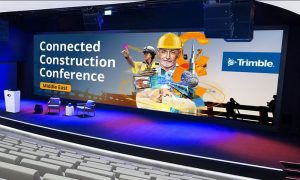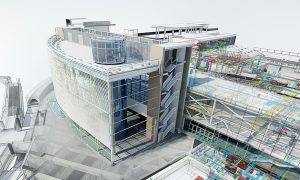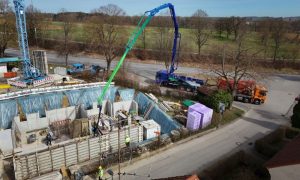A digital future in construction on the horizon?
Jason Saundalkar talks to Trimble Solutions’ Paul Wallett about the adoption of new technology and digitalisation following the outbreak of COVID-19

The construction industry is one of the oldest and largest in the world and despite the growing complexity of projects and steadily decreasing stakeholder margins, it has been one of the slowest to embrace technology and digitalisation. In recent years, certain firms had started to embrace technology and undertake the digitalisation of their workflows and data on an ad-hoc basis.
Paul Wallett, regional director, Trimble Solutions – Middle East and India states, “Prior to the outbreak of the pandemic the primary drivers were predominantly related to the type and complexity of projects we see across the Middle East region, architecturally challenging in nature, which necessitated the need for better tools to help execute on time and within the budget. Most of the design, engineering firms and contractors involved in these projects had implemented BIM to some degree, as well the tender documents incorporated BIM standards as a mandatory requirement for companies to qualify on the bids.”
“The caveat to that, however, was the level of detail that was a matter of debate and often left open, as long as a master BIM model was supplied back to the owner/operator at the end of the contract. Most often, the work was completed using traditional 2D methods.”
He adds, “With the onset of COVID and remote working, many companies who were otherwise able to get by using a mix of traditional approach and contract BIM requirements to adopt model-based workflows, are now having to digitise to survive. The outcome of COVID-19 has been a large uptake in model-based cloud sharing platforms and services to collaborate, coordinate and share data with the stakeholders. As per a McKinsey report, the industry leapt forward five years in the adoption of digital workflows and processes as a consequence of the pandemic. At the beginning of the lockdown, to keep the wheels of the construction industry moving, we offered our cloud model sharing solution Tekla Model Sharing free of charge to support our customers.”
The Pandemic Push
Describing the 2020/2021 period, Wallett notes, “2020/2021 has proved to be a watershed year for the adoption of digitalisation and technology in the construction industry. The general slowdown or even the complete shutdown seen during this period pushed many industry players into relooking at their operating models and making some much needed changes, most prominently related to digitalisation and automation. Trimble saw significant uptake in cloud-based technologies such as Trimble Connect and Tekla Model Sharing across the Middle East region since the outbreak of COVID-19.”
Wallett notes that the nature of the industry is such that there is a fair bit of dependence on the presence of a large volume of workforce onsite for physical work. The non-physical work that includes architectural design, planning and structural engineering happens offsite; but the industry is yet to embrace true digitalisation and automation to an extent that will help it efficiently execute and manage offsite workflows as well.”
He comments, “To accelerate this process, Trimble has taken affirmative actions to support its customers’ businesses through enhanced productivity. By moving to a subscription only approach, we have widened the reach and availability of our flagship product, Tekla Structures, the flagship BIM software. Our offerings enable seamless collaboration over the cloud, allowing the users working remotely to deliver without loss of efficiency, which is very much the need of the hour during this worldwide medical emergency.”
Discussing the rationalisation for offering subscription-based services, Wallett states that the move came from a desire to better service its customers and the broader industry. “The pandemic has changed the way industries used to function and our customers have massively accelerated their digitalisation efforts since last year and are now depending on remote working more than ever. We stand committed to helping our customers generate the maximum value out of their investments in our technologies and solutions. And our shift from perpetual licenses-based model to a subscription-based model underlines this commitment. This allows our customers to minimise their capital investments and avail services to whatever extent and for as long they wish to use,” he remarks.
“Businesses across industries are assessing how best they can embrace op-ex models for investments in technologies, machinery as well as other assets. The global technology industry is also responding to this trend and is increasingly offering software on a subscription model, as it offers better flexibility and control over cash flows, and lower entry costs.”
He adds, “The shift to a subscription model is an extensive process, and necessitates wide-ranging changes in the technical, business architecture and operational aspects of an organisation. We believe it was all well worth the effort, as our customers stand to gain tremendously from subscription-based offerings and pricing in terms of two key benefits: lower costs that are tied closely with business value generated from these investments, and access to latest features and innovations speedily and easily. The shift allows many more new customers to start adopting world class tools, democratize technology and bring its benefits to their doorstep, impacting the society at large in an expansive, positive way.”
Industry Trends & Challenges
Speaking about prevalent trends in the regional construction industry, Wallett points to digitalisation and sustainability as key trends driving the industry. He notes that these two trends are critical to ensure sustainable growth in the industry going forward.
He remarks, “The AEC industry in the region is now waking up to the need to digitalise construction sustainably and is increasingly recognising its long-term benefits and business value. With the region’s construction industry projected to grow at an average annual rate of 3.8% by 2025, Trimble’s Connected Construction is already responding to the projected demand.”
“Sustainability starts with connected construction and the answer to increasing sustainability and lowering the construction industry’s carbon emissions, costs, and material waste lies in connected construction. However, to eliminate waste, boost productivity, and truly enable a connected team, changes must be applied across the entire construction continuum.”
He elaborates, “Before construction begins, architects, engineers and designers can use software and analytics technology such as SketchUp PreDesign and Sefaira to create eco-friendly models, while also considering other aspects of the project’s environmental impact such as material, water, and energy needs. With advances in technology, users can explore different concepts nimbly and with ease, without fully defined parameters, to make sustainable design decisions.”
“Advances in building performance analysis tools allow answering questions early on about heating and cooling loads, lighting, appliances, and other energy demands of the completed project, owners can make more informed decisions about the long-term environmental impacts of their projects.”
“Companies are finding that most construction waste can be reduced or eliminated by adopting a constructible process utilising digital tools and data in building information models (BIM) at the outset of a project. With this approach, all phases and trades are connected, models and workflows are content-enabled, and data-rich constructible models drive smarter workflows. These models include construction-ready content that is easily accessible through open formats. A key part of this process is the constructible, data-rich 3D model that goes beyond simple geometry and contains accurate and intelligent information that can be used throughout the project lifecycle,” he comments.
“File-sharing systems can ensure that everyone has the most recent set of plans and is working toward the same goals. By collaborating with all stakeholders, knowing what is expected and having the right equipment in place, there is less room for error. It puts forward an advanced method which embraces the need for greater accuracy and efficiency for all construction industry players, which include architects, engineers, contractors, and owners.”
“With increased awareness and focus on sustainable construction, and with connected construction at the core, the regional industry will only hasten the adoption of technology solutions. Already, AEC companies globally have experienced high success in project delivery using Trimble technology, both at the job site and in office, reporting up to 50% less rework, up to 30% cost savings, informed decision making, and up to 30% increase in machine productivity and fuel savings.”
Asked about some of the common issues construction companies in the region deal with on projects, Wallett explains, “Miscommunication, lack of coordination, and data misinterpretation are some of the key issues the AEC firms often face in their day-to-day work. These issues have consequences because they give rise to errors such as data entry duplication; there have been instances of disputes among contractors, engineers, and business owners; resulting into decreased productivity.”
“Trimble’s portfolio of software can help narrow the gaps and resolve the issues. These solutions are designed to connect stakeholders including architects, engineers, fabricators, MEP contractors, general contractors, construction managers, and building owners and occupiers, whether they are in the office or on-site, and achieve transformative results. This seamless collaboration and coordination make the process of construction quicker, safer and more cost-efficient thus enhances productivity and leads to better utilisation of materials, assets and workers.”
A Tech Driven Industry
New technology and solutions are coming to the market, some of which are expected to have a significant positive impact on the delivery of projects.
Commenting on new technology that could potentially become more commonplace in the industry, Wallett notes, “The construction industry is already witnessing many changes with increasing customer sophistication, higher emphasis on total cost of ownership than just initial investment, updated regulations for safety, sustainable construction, building codes standardisation, and digitalisation of processes. These disruptions have led to various innovations such as modular, factory-based approach to construction, data driven digital workflows (constructible BIM), automated prefabrication in off-site ‘factories’, Augmented Reality (AR) to robotics or drone-powered scanning technology.”
“We believe that connected construction is the greatest defense against the inefficiencies that stem from data locked up in silos, and effective use of data has the potential to impact AEC sector’s efficiencies like never. With intelligent data fueling fabrication, prefabrication, and lean construction, companies can reduce waste, improve productivity, and increase profitability across the project. Prefabrication is already contributing to creating more sustainable models by enabling companies to build components in a controlled environment with all necessary tools and equipment readily on hand, which increases speed and predictability, and it’s quite popular even now, and we expect it to grow speedily in the future.”
“During site prep, augmented reality on excavators gives operators the ability to view 3D models in a real-world environment at a true-life scale, right inside the cab in the context of their existing surroundings. These machine control systems are improving the accuracy and efficiency of heavy earthmoving equipment, thereby enabling job completion in less time, and using less fuel.”
“Further, given the pandemic driven new safety requirements, Wifi and GPS enabled wearables for worker safety and regulations are also expected to be widely used at construction sites,” he says.
He concludes, “Many large GCC construction companies are now leveraging technology more extensively to complete their projects within timeline. Healthy renewed investor interest in several mega projects in the region is also opening up new growth opportunities for tech organisations like ours. What COVID-19 and the oil price fall of last year did was to focus minds on accelerating economic diversification and digitalization of processes, and from that we expect many new opportunities to emerge.”

















